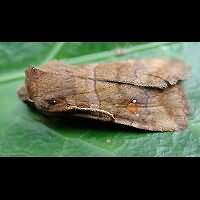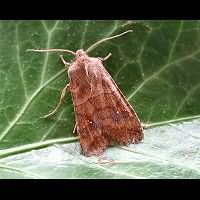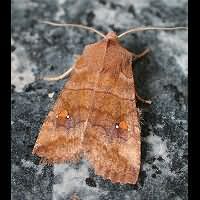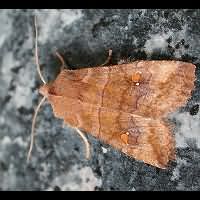Satellite Eupsilia transversa
The Satellite is unmistakable. There is some variation in colour, though. The groundcolour may be orangebrown or cinnamonbrown, but occasionally it is yellowish brown or greyish brown. There is one striking marking: a colourful small spot accompanied by two small white dots. The big spot usually is orange, but sometimes it is yellow or white. In some individuals the spot on one wing has a different colour than the spot on the other wing. The wingspan is some 40 to 48mm.
The eggs are being deposited one by one in March and April. The caterpillar of the Satellite sleeps during the day and feeds at night. When resting it hides between some leaves which it spins together. Except for the leaves of the host plant the larvae also feed on eachother, other caterpillars or larvae of other insects. This is one of the very few species of caterpillars capable of biting humans in their finger.
In Central and Western Europe the Satellite is single-brooded. Because it overwinters being adult, it may be seen during a long stretch of time: from September to deep in April. Sometimes on the wing in mild winter nights. It is easily attracted to light and sugar. In autumn it feeds on rotting fruit and Ivy blossom. In winter on tree juices and in spring it regularly visits catkins. Is seen in parks and gardens frequently. If you catch it, it may appear to be a good model for photographers at first, for it may sit motionless for a moment and may sometimes even be handled. But be aware: it may fly off at any time without previous warning! Very common over much of Europe, including England, Wales and Ireland. A local species in Southern Scotland and a very rare local species in other parts of Scotland, if present. Very rare and extremely local in the Hebrides. Abundant on the Channel Islands.
The Satellite is unmistakable. There is some variation in colour, though. The groundcolour may be orangebrown or cinnamonbrown, but occasionally it is yellowish brown or greyish brown. There is one striking marking: a colourful small spot accompanied by two small white dots. The big spot usually is orange, but sometimes it is yellow or white. In some individuals the spot on one wing has a different colour than the spot on the other wing. The wingspan is some 40 to 48mm.
The eggs are being deposited one by one in March and April. The caterpillar of the Satellite sleeps during the day and feeds at night. When resting it hides between some leaves which it spins together. Except for the leaves of the host plant the larvae also feed on eachother, other caterpillars or larvae of other insects. This is one of the very few species of caterpillars capable of biting humans in their finger.
In Central and Western Europe the Satellite is single-brooded. Because it overwinters being adult, it may be seen during a long stretch of time: from September to deep in April. Sometimes on the wing in mild winter nights. It is easily attracted to light and sugar. In autumn it feeds on rotting fruit and Ivy blossom. In winter on tree juices and in spring it regularly visits catkins. Is seen in parks and gardens frequently. If you catch it, it may appear to be a good model for photographers at first, for it may sit motionless for a moment and may sometimes even be handled. But be aware: it may fly off at any time without previous warning! Very common over much of Europe, including England, Wales and Ireland. A local species in Southern Scotland and a very rare local species in other parts of Scotland, if present. Very rare and extremely local in the Hebrides. Abundant on the Channel Islands.







